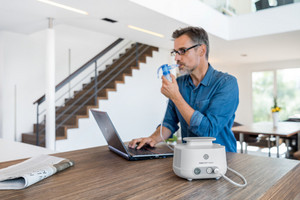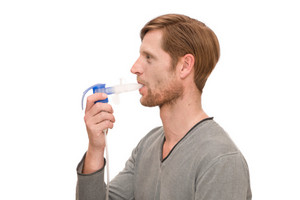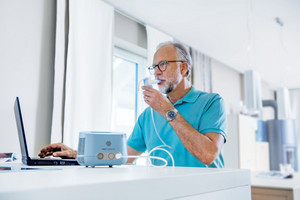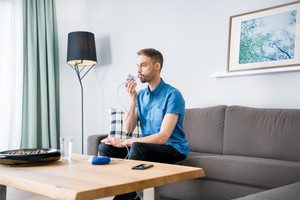People with lung disease such as cystic fibrosis, chronic bronchitis or primary ciliary dyskinesia (PCD) spend a lot of time every day on their breathing therapy and inhalation to keep their lungs free from secretions. Every minute you can save without losing the benefits for your lungs is therefore welcome.

We talked to Rita Kieselmann, a physiotherapist and respiratory therapist with many years of experience. She gives tips on how you save same time on your daily therapy. The therapy is as effective, even though it is shorter.
Often patients inhale first with a nebuliser and then do autogenic drainage to transport the mucus out of the lungs. But inhalation and modified autogenic drainage are easy to combine, so you can clear your bronchial tubes during the inhalation session. How does it work? Check out our instructions on combining inhalation and modified autogenic drainage.
Patients whose lungs are hyperventilated and who are short of breath often use a PEP system after they have used the nebuliser. PEP means that you exhale against resistance; this keeps your airways open and means they cannot collapse. PEP breathing and inhalation are actually really easy to successfully combine.



The PARI PEP S System can be fitted to the nebuliser of the PARI BOY and the PARI COMPACT2. This means that you already exhale through the PEP system during your inhalation session, and you do not need to do it separately afterwards. PEP breathing after inhalation is then no longer necessary or can be shortened.

All PARI inhalation devices are known for their high level of efficacy combined with short inhalation times. One of the PARI inhalation devices is, however, especially fast: the eFlow®rapid. This device is based on vibrating membrane technology, which is what makes it so fast.
And also: The more active substance to reach the lung per minute, the more efficient the device. There is an objective parameter used to rate efficiency: the Respirable Drug Delivery Rate (RDDR). It measures the dose per minute to reach the lungs. A high RDDR is therefore a sign of an efficient nebuliser system.
This article was written in cooperation with the experienced physiotherapist and respiratory therapist Rita Kieselmann, who has been working in this field since 1974. Her focus is on the treatment of children and adults with chronic respiratory diseases.
Rita Kieselmann is the founder of the Physiotherapy working group in the Mukoviszidose e. V. (Cystic Fibrosis Association in Germany). She has also developed self-help techniques for clearing mucus such as modified autogenic drainage and others.
Visit our blog for more tips on inhalation, therapy and living with chronic or acute respiratory disease:
Note: The information in this blog post is not a treatment recommendation. The needs of patients vary greatly from person to person. The treatment approaches presented should be viewed only as examples. PARI recommends that patients always consult with their physician or physiotherapist first.
An article written by the PARI BLOG editorial team.
© 2025 PARI GmbH Spezialisten für effektive Inhalation